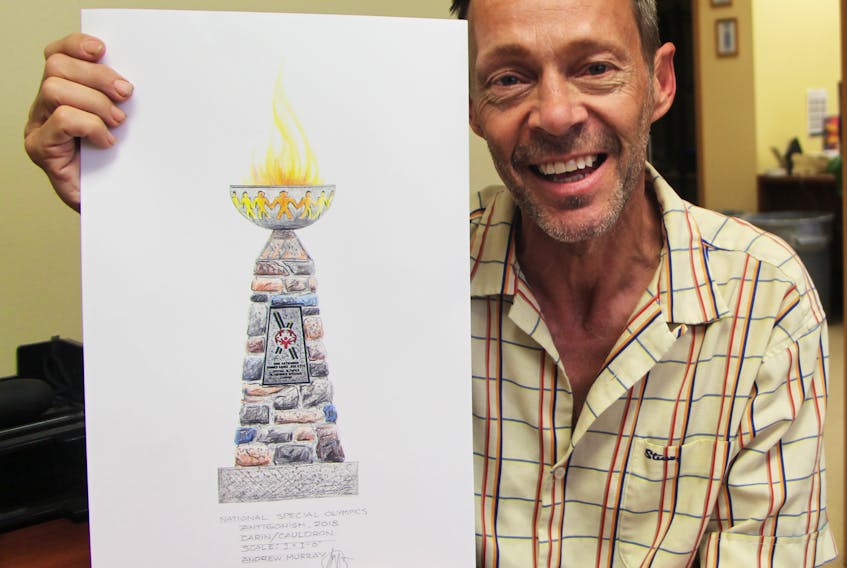Here is a little Special Olympics Canada 2018 Summer Games quiz; which of the following groups, from all across Canada, will be coming to Antigonish? Your choices are; (a) Special Olympic athletes, (b) Special Olympic coaches, (c) parents, friends and supporters of Special Olympic athletes, or (d) stones.
The answer – all of the above – including the odd ‘d’ choice.
Stones, from locations across the country, have been assembled in Antigonish to become part of a nine-foot cairn which will serve as the base for the cauldron for the Olympic flame, and become a legacy of the 2018 Games being held in Antigonish.
At the completion of the Games, with the flame extinguished, the cairn will be moved to a permanent home in Cairn Park, near downtown Antigonish.
Town of Antigonish councillor Mary Farrell, chair for the committee looking after the opening and closing ceremonies, said the idea for the cairn evolved out of brainstorming about the Olympic flame and opening ceremonies.
Farrell said she started by thinking about how best to represent Canada, Nova Scotia, Antigonish and St. F.X., with the university playing host to many of the Games’ activities. Of those four, Nova Scotia imagery was the first to come to mind.
“Quintessential Nova Scotia, well we’re ‘Canada’s ocean playground’ … 90 per cent surrounded by water,” Farrell said, noting her thoughts then turned to what she actually needed to have in place for the start of the Games.
“We need a cauldron, a stage and we need to decorate that stage,” she said. “And all I could think of was things like a lighthouse, a wharf, pylons seen in the water, jute rope to look like the side of a wharf.”
It was an easy transition from thinking about the shape of a lighthouse to a cairn and Farrell thought she could use both, the former more decorative for the stage and the latter, the real deal.
The idea of having the cairn include stones from each province and territory came next and rather than rely on each province’s Special Olympic governing body to come up with the stones, Farrell and Town of Antigonish recreation direction Tricia Cameron just started calling people they knew around the country and the response was tremendous; a diversity of stones coming from interesting locations and with terrific backstories. And all generously sent to Antigonish without costing the local organizing committee a dime.

“This will be your home for the Games and we want you to feel at home, to feel welcome,” Farrell said, while speaking at a Special Olympics’ lead-up press event, back in May.
“What better way than to have a piece of your home here for you. A stone from each province and territory will be placed in our cairn to show unity of purpose in the freedom which activity, sport and cooperation gives. We reached out to families and friends with Antigonish connections across Canada and they came through for us.”
Fellow town councillor Andrew Murray, a talented artist and designer, volunteered his skills to create the finish look for the cairn.
“It’s symbolic of the lighthouse,” Murray said, holding up a sketch of the finished cairn.
He added that people have been commenting that it also reminds them of a famous trophy.
“It does look reminiscent of the Stanley Cup; you can’t get much more Canadian than that,” Murray said, adding that fact is just a happy coincidence and since both are related to sports, it’s just another good fit.
The different coloured stones from locations across Canada give the cairn a colourful look and each stone is being etched with the province’s abbreviation.

“If an athlete is from Saskatchewan, there will be a stone that will have the abbreviation for Saskatchewan and they can touch it for good luck,” Murray said.
He is also volunteering his talents to work with the opening and closing ceremonies’ look.
“It’s going very well,” he said, in an early July interview, of the preparations.
“There are a lot of people involved. Last year’s Canada 150 extravaganza was kind of a rehearsal, but we’re, primarily, focused on the set design, which is good.”
Farrell said the opening ceremony is two hours long.
“Basically, it will focused on the athletes; we want them to be the star attraction,” she said, adding former Canadian Olympic swimming athlete Mark Tewkesbury, the current chair and president of Special Olympics Canada board of directors, will be one of the speakers.
Farrell said the ceremony will feature the different cultures in northeastern Nova Scotia, such Mi’kmaw, Acadian and African-Nova Scotian.
“It will be dramatic; we don’t do things right here, we do them prefect,” she said, emphasizing, again, the athletes will be the focus.
“We want them to feel welcomed.”









